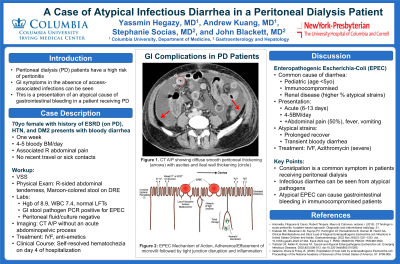Tuesday Poster Session
Category: GI Bleeding
P4195 - A Case of Atypical Infectious Diarrhea in a Peritoneal Dialysis Patient
Tuesday, October 29, 2024
10:30 AM - 4:00 PM ET
Location: Exhibit Hall E

Has Audio

Yassmin Hegazy, MD
New York-Presbyterian/Columbia University Irving Medical Center
New York, NY
Presenting Author(s)
Yassmin Hegazy, MD1, Andrew G. Kuang, MD2, Stephanie Socias, MD3, John W. Blackett, MD, MS2
1New York-Presbyterian/Columbia University Irving Medical Center, New York, NY; 2Columbia University Irving Medical Center, New York, NY; 3Columbia University, New York, NY
Introduction: While patients receiving peritoneal dialysis (PD) have an increased risk of peritonitis, gastrointestinal symptoms in the absence of access-associated infections can be seen. This case demonstrates a presentation of an atypical cause of gastrointestinal bleeding in a patient receiving PD.
Case Description/Methods: A seventy-year-old Hispanic male with a history of end-stage renal disease (ESRD) on PD, hypertension, and Type Two Diabetes Mellitus presents with one week of abdominal pain and bloody diarrhea. The patient reported having four to five bloody bowel movements per day. He had no recent travel or sick contacts, and denied alcohol, tobacco, and illicit drug use. On admission, he had stable vital signs, right-sided abdominal tenderness on physical exam, and maroon-colored stool on his digital rectal exam. Labs were notable for a hemoglobin of 8.9 g/dL (from baseline level 10 g/dL), white blood cell count 7.37 x10^3/uL and normal liver function tests. Computed Tomography (CT) scan was without acute abdominopelvic process. Infectious workup was notable for a gastrointestinal pathogen PCR positive for enteropathogenic Escherichia-coli (EPEC) in the stool and negative infection in the peritoneal fluid cell count and culture. The gastroenterology team was consulted and the patient’s bleeding was likely from EPEC infection. The patient was treated with supportive care with intravenous fluid and anti-emetic medications with symptom improvement and resolved hematochezia on day four of hospitalization.
Discussion: Patients receiving PD have a high risk of peritonitis and constipation, however infectious diarrhea can also be seen from atypical pathogens as seen in our patient’s presentation. EPEC is a common cause of diarrhea in pediatric patients, however immunocompromised patients are likely to carry a higher burden of EPEC with resistant and atypical strains as well as an associated prolonged recovery and transient bloody diarrhea. EPEC infections are treated with symptomatic therapy and fluid hydration, however Azithromycin can be given in patients with severe symptoms. Patients with ESRD carry a high risk of clostridium-difficile-associated diarrhea and ischemic colitis, however it’s also important to recognize other atypical pathogens such as EPEC that can be a cause of bloody diarrhea in that patient population. More studies are needed in order to better understand atypical virogenic pathogens causing diarrhea and gastrointestinal bleeding in patients receiving PD.
Disclosures:
Yassmin Hegazy, MD1, Andrew G. Kuang, MD2, Stephanie Socias, MD3, John W. Blackett, MD, MS2. P4195 - A Case of Atypical Infectious Diarrhea in a Peritoneal Dialysis Patient, ACG 2024 Annual Scientific Meeting Abstracts. Philadelphia, PA: American College of Gastroenterology.
1New York-Presbyterian/Columbia University Irving Medical Center, New York, NY; 2Columbia University Irving Medical Center, New York, NY; 3Columbia University, New York, NY
Introduction: While patients receiving peritoneal dialysis (PD) have an increased risk of peritonitis, gastrointestinal symptoms in the absence of access-associated infections can be seen. This case demonstrates a presentation of an atypical cause of gastrointestinal bleeding in a patient receiving PD.
Case Description/Methods: A seventy-year-old Hispanic male with a history of end-stage renal disease (ESRD) on PD, hypertension, and Type Two Diabetes Mellitus presents with one week of abdominal pain and bloody diarrhea. The patient reported having four to five bloody bowel movements per day. He had no recent travel or sick contacts, and denied alcohol, tobacco, and illicit drug use. On admission, he had stable vital signs, right-sided abdominal tenderness on physical exam, and maroon-colored stool on his digital rectal exam. Labs were notable for a hemoglobin of 8.9 g/dL (from baseline level 10 g/dL), white blood cell count 7.37 x10^3/uL and normal liver function tests. Computed Tomography (CT) scan was without acute abdominopelvic process. Infectious workup was notable for a gastrointestinal pathogen PCR positive for enteropathogenic Escherichia-coli (EPEC) in the stool and negative infection in the peritoneal fluid cell count and culture. The gastroenterology team was consulted and the patient’s bleeding was likely from EPEC infection. The patient was treated with supportive care with intravenous fluid and anti-emetic medications with symptom improvement and resolved hematochezia on day four of hospitalization.
Discussion: Patients receiving PD have a high risk of peritonitis and constipation, however infectious diarrhea can also be seen from atypical pathogens as seen in our patient’s presentation. EPEC is a common cause of diarrhea in pediatric patients, however immunocompromised patients are likely to carry a higher burden of EPEC with resistant and atypical strains as well as an associated prolonged recovery and transient bloody diarrhea. EPEC infections are treated with symptomatic therapy and fluid hydration, however Azithromycin can be given in patients with severe symptoms. Patients with ESRD carry a high risk of clostridium-difficile-associated diarrhea and ischemic colitis, however it’s also important to recognize other atypical pathogens such as EPEC that can be a cause of bloody diarrhea in that patient population. More studies are needed in order to better understand atypical virogenic pathogens causing diarrhea and gastrointestinal bleeding in patients receiving PD.
Disclosures:
Yassmin Hegazy indicated no relevant financial relationships.
Andrew Kuang indicated no relevant financial relationships.
Stephanie Socias indicated no relevant financial relationships.
John Blackett: Mahana Therapeutics, Inc – Consultant.
Yassmin Hegazy, MD1, Andrew G. Kuang, MD2, Stephanie Socias, MD3, John W. Blackett, MD, MS2. P4195 - A Case of Atypical Infectious Diarrhea in a Peritoneal Dialysis Patient, ACG 2024 Annual Scientific Meeting Abstracts. Philadelphia, PA: American College of Gastroenterology.

